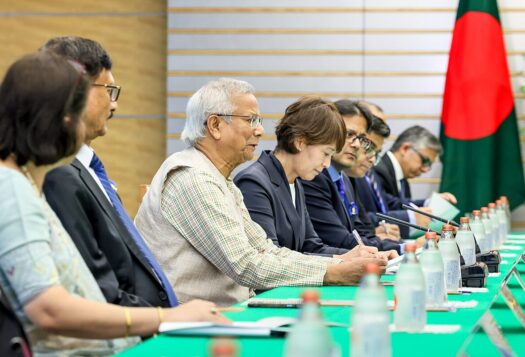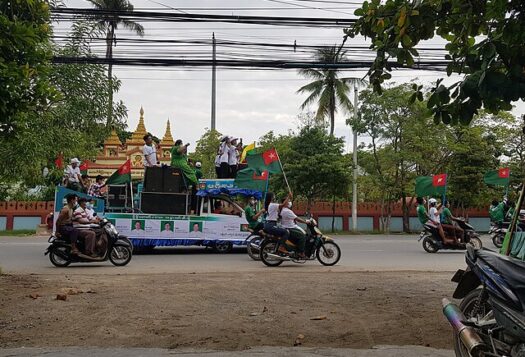
The reemergence of the radical religious right as participants in the electoral process is a major step backwards for Pakistan’s democratic experiment. Or is it? While the rise of the Tehreek Labbaik Pakistan (TLP) and the Milli Muslim League (MML) have raised concerns, the radical religious right’s participation in Pakistan’s upcoming general elections is dubious at best. The capacity of such parties to mobilize supporters, as seen in the TLP’s sit-in in Islamabad last year, furthers brings up fears of a radicalized Pakistani society both locally and internationally. However, sloganeering based on “Islamic values” and religious intolerance is not likely to bring enough votes for a Pakistani electorate increasingly concerned with socio-economic needs. While commentators speculate on the popularization of terrorists within these groups, their ingress into the political sphere as major political actors remains limited in the context of Pakistan’s majoritarian electoral system.
Reemerging Religious Actors
Following Nawaz Sharif’s disqualification from office last July, Jamaat-ud-Dawa (JuD), the political arm of the Lashkar-e-Taiba, announced its formal entry into politics through the MML. At the same time, TLP mobilized its supporters as the government’s Elections Bill came under fire for tampering with the oath declaration for parliamentary candidates – according to the TLP, the Bill was a form of appeasement, paving the way for Ahmadis to cast their votes alongside Muslim voters. By September, both parties had made their presence felt in the NA-120 by-elections, where TLP and MML-backed candidates received around 11 percent of the votes. This significantly raised fears of an electorate now willing to vote in large numbers for extremist parties.
Sloganeering based on ‘Islamic values’and religious intolerance is not likely to bring enough votes for a Pakistani electorate increasingly concerned with socio-economic needs.
Before indulging in such concerns, however, it is important to reflect on previous participation of religious-affiliated political groups in Pakistan’s politics: most notably, the Muttahida Majlis-e-Amal Pakistan (MMA), an alliance of religious-affiliated political parties, won 59 seats in parliament, formed government in Khyber Pakhtunkhwa (KP), and partner in the ruling coalition in Balochistan following the 2002 elections. MMA’s electoral success was short-lived, however, when, in 2008, the coalition attained only five seats in the National Assembly and a mere 14 in the KP parliament, where it was previously in power. MMA’s relative failure in the 2008 elections can be attributed to anti-incumbency sentiment and MMA’s internal bickering. Furthermore, the fact that the majority of seats the MMA won in 2002 were in KP highlights the party’s limited geographical appeal and reach in Pakistan. The MMA was overshadowed in the 2008 elections with a rising secular Pashtun ethno-nationalism led by the Awami National Party (ANP). Now prone to internal rifts, the MMA is unlikely to attract a large voter base in the upcoming elections.
Hence, before one draws conclusions on the rising religious wave, it is pertinent to note that barring the 2002 elections, the religious right’s political parties have been traditionally peripheral in Pakistan’s general elections. The key question is if this is bound to change in 2018 with the rise of more radicalized, populist, and mobilized religious parties.

Incoherent Religious Bloc
It is important to recognize that the religious right is not all one and the same. Both the Ahle Hadees and Ahle Sunnat belong to the Sunni sect of Islam, but differ over whether Hadees (statements of the Holy Prophet) or Sunnah (the Prophet’s way of life) holds primary importance in understanding the tenets of Islam. Politically, those in support of the Ahle Hadees movement lean more towards an activist, jihad-based practice of Islam, while adherents of the Ahle Sunnat follow a more Sufi-inspired version of non-violence. However, recently, it is the traditionally pliant Ahle Sunnat that has become more militant in orientation.
These differences should be understood in the context of TLP, which are in line with this rising militant current. This has led to differences within the group and between the TLP and Jamiat Ulema-e-Pakistan (JUP). The JUP has kept its distance from the TLP, reiterating that the latter’s use of militancy stands against to Sufi-influenced, tolerant values of the Ahle Sunnat. The JUP has subsequently joined the MMA, which, interestingly, includes both Ahle Hadees and Ahle Sunnat sects as well as Allama Sajid Naqvi’s Shiite-led Tehreek-i-Islami, the Jamat-e-Islami, and Jamiat Ulema-e-Islam. This old guard now faces electoral competition from the TLP and Ahle Hadees-influenced Allahu-Akbar Tehreek (AAT), a competition that is at the heart of the intra-religious divide in Pakistan. With the TTP, AAT, and MMA unlikely to forge an electoral alliance due to these divisions, the upcoming elections will likely highlight a divided religious electorate, stymying any expectations that the religious right will replicate the success of the MMA in the 2002 elections.
Besides these sectarian differences, two other factors will serve as a check on the success of the religious right in the upcoming elections. First, the upcoming elections will probably see increased votes, especially for TLP and AAT, but these are less likely to be translated into a significant number of seats. As three recent by-elections in Punjab – Lahore, Chakwal, and Lodhran – made clear, the increased votes for the TLP have not been enough to secure seats in parliament.
Second, the electoral battle for both TLP and AAT taking place predominantly in Punjab signifies these parties’ relatively lesser appeal in other provinces. The parties will challenge and likely play the role of spoilers of the PML-N vote bank concentrated in Northern and Central Punjab, basing their electoral agenda on the Elections Bill controversy. However, since their capacity to win seats is limited, they are less likely to be major players in the post-elections scenario of coalition politics at the provincial or federal levels.
Future Prospects
The future of radical religious representation in Pakistan’s polity both depends on and can be curtailed by timely legal action to deal with radical religious groups. While the Election Commission disallowed party registration to the MML, the ease with which the party was able to run its candidates under the AAT platform suggests that laws dealing with such groups need to be tightened further. If existing laws allow radical religious groups space for maneuverability, the specter of radical religious right in the political sphere will remain.
The ability of religious actors to dominate Pakistan’s electoral space is majorly dependent on what kind of socio-economic program they are willing to offer to the masses.
In addition, the ability of religious actors to dominate Pakistan’s electoral space is majorly dependent on what kind of socio-economic program they are willing to offer to the masses. A look at the MML’s website indicates that their agenda involves four key themes including self-determination for India-administered Kashmir, the protection of minorities, women’s empowerment, and a defense of the founding ideology of Pakistan. Framed under a liberal pretense in which minorities and women’s rights are protected and not usurped, the party’s Islamic rhetoric exists also with an expressed desire to address Pakistan’s economic development. However, without attending to the latter, the party can expect little in terms of popular support, especially from Pakistan’s burgeoning youth population.
Conclusion
Pakistan faces a key challenge in the electoral mobilization of a radical religious right with the capability to project their social power and sensitize more secular political parties and leaders towards issues of religion, as mainstream parties such as the PML-N and the Pakistan Tehreek-e-Insaf (PTI) have been accused of courting the favor of radical religious parties for their own electoral agendas. While this transpires, however, these parties still have far to go in making key inroads into Pakistan’s electoral sphere. If anything, the upcoming elections’ results will provide a good estimation of the popular support of such parties, indicated in their percentage vote share.
Editor’s Note: As Pakistani voters head to the polls on July 25 in what will be the second time in the country’s history that one civilian government will transfer power to another, SAV contributors Umair Jamal, Farhan Siddiqi, Hamzah Rifaat, and Rizwana Abbasi assess the likely outcome, its impact on Pakistan’s domestic economic agenda and foreign policy, and what role key stakeholders such as the military and the religious groups may play in the process. Read the entire series here.
***
Click here to read this article in Urdu.
Image 1: bm1632 via Flickr (cropped)
Image 2: Arif Ali/AFP via Getty Images


